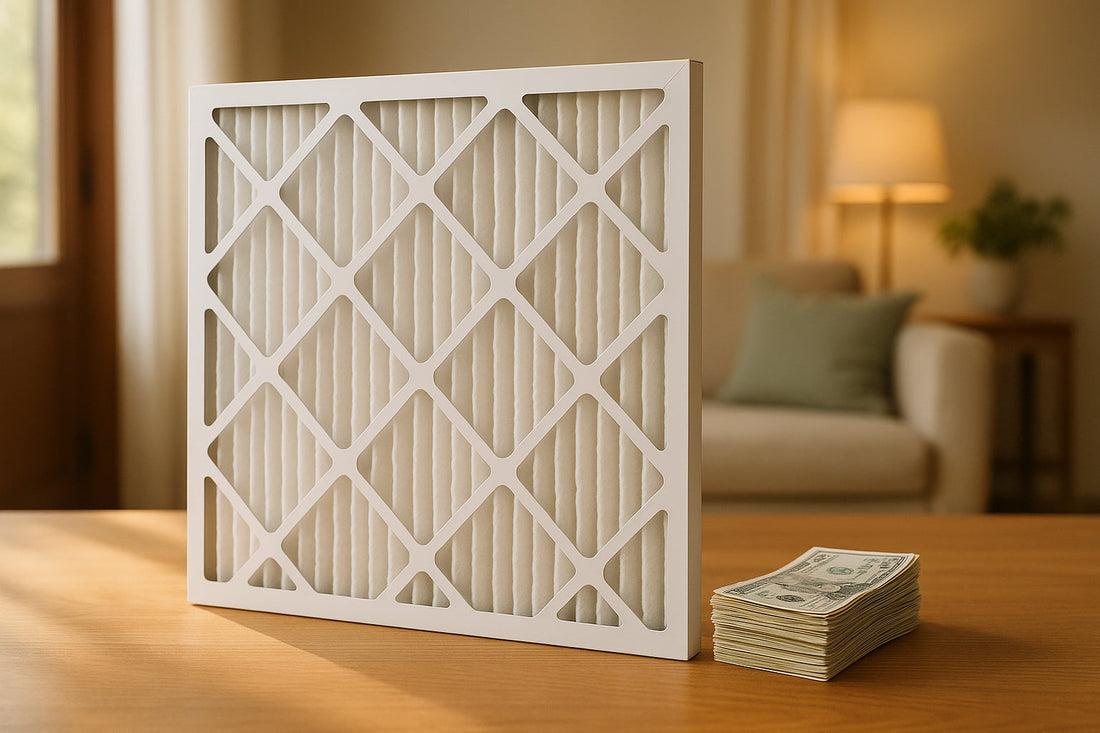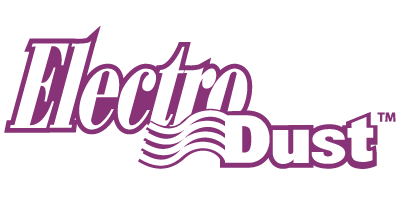
Stop Throwing Money (and Filters) in the Trash
Share
Disposable furnace filters are expensive and contribute to landfill waste. Switching to reusable filters can save you hundreds of dollars over time and eliminate waste from dozens of discarded filters. Here's why reusable filters are a smart choice:
- Cost Savings: A $130 reusable filter can last 10+ years, replacing up to 60 disposable filters and saving $.
- Less Waste: Americans throw away 3 billion disposable filters annually. One reusable filter can prevent 20–60 filters from ending up in landfills.
- Better Air Quality: With a MERV 7 rating, reusable filters trap dust, pollen, and allergens while maintaining proper airflow.
- Durability: Made from washable materials with sturdy frames, reusable filters are designed for repeated use and easy cleaning.
How It Works: Reusable filters use electrostatic technology to trap particles. Clean them monthly with water and mild soap, then air dry before reinstalling. For homes with pets or allergies, frequent cleaning ensures optimal performance.
Switching to reusable filters isn’t just about saving money - it’s about simplifying maintenance and reducing waste. Start by choosing the right size for your HVAC system and follow proper care instructions for years of reliable use.
Financial and Environmental Benefits of Reusable Filters
Reusable filters might come with a higher price tag upfront, but they deliver substantial savings over time. For American households, the combination of financial and environmental advantages makes them a practical and eco-friendly choice.
Initial Investment vs. Long-term Savings
At first glance, spending $120 to $180 on a reusable filter might seem costly compared to a $15 disposable one. However, the long-term savings quickly offset this expense. A single reusable filter can replace anywhere from 20 to 60 disposable filters throughout its lifespan, making it a cost-effective option.
For example, if disposable filters cost $60 annually, a $130 reusable filter pays for itself in just over two years. With proper maintenance, these filters can last up to 10 years, leading to potential savings of $470 over their lifetime. Beyond the financial perks, reusable filters also help cut down significantly on waste.
Reducing Landfill Waste
Switching to reusable filters also brings a noticeable environmental benefit. Each year, Americans throw away about 3 billion disposable filters, most of which end up in landfills or incinerators. These filters are often made from synthetic plastics that take decades to decompose and are not recyclable.
A single household typically discards 4 to 12 disposable filters annually. By switching to reusable filters, you eliminate this waste entirely. To put it in perspective, using one reusable filter is equivalent to keeping around 105 plastic bottles out of landfills.
Cost Comparison: Disposable vs. Reusable Filters
The following table highlights the financial benefits of reusable filters compared to disposable ones:
| Filter Type | Initial Cost | Annual Cost | 5-Year Total | 10-Year Total | Filters Discarded |
|---|---|---|---|---|---|
| Disposable | $15 | $60 | $300 | $600 | 40–120 filters |
| Reusable | $130 | $0 | $130 | $130 | 0 filters |
| Savings | –$115 | $60 | $170 | $470 | 40–120 fewer |
Reusable filters also save you time and effort. You won’t need to worry about last-minute trips to buy replacements, finding storage for extra filters, or keeping track of replacement schedules. For families with pets, allergies, or dustier homes, where filters need changing more often, the financial and environmental benefits only grow.
How Reusable Filter Technology Works
Reusable filters use a combination of advanced materials and electrostatic technology to trap airborne particles while maintaining their efficiency through repeated cleaning cycles.
Core Features of Reusable Filters
Unlike disposable filters, reusable furnace filters are crafted from washable synthetic materials designed to retain their shape and effectiveness even after multiple cleanings. These filters are built with durable plastic or aluminum frames that can withstand exposure to water and cleaning agents, ensuring longevity.
The key technology at play is electrostatic attraction. This process generates an electric charge on the filter fibers, which helps capture and hold airborne particles like dust, pollen, and pet dander as air flows through the system.
Reusable filters are typically rated at MERV 7, striking a balance between effective particle removal and maintaining proper airflow. This rating ensures the filters can handle dust, mold spores, and other common allergens without overburdening your HVAC system. Filters with higher MERV ratings (10–16) may block airflow in standard home systems, potentially forcing the furnace to work harder. MERV 7 filters, on the other hand, improve indoor air quality while keeping your heating and cooling equipment running efficiently.
ElectroDust's design innovations take these essential features a step further.
ElectroDust Filter Benefits

ElectroDust filters build on the core advantages of reusable filters, offering features tailored to meet the needs of North American homeowners. Manufactured in Canada, these filters use electrostatic technology and maintain a MERV 7 rating, making them an excellent match for residential HVAC systems across the United States.
One standout feature is ElectroDust's warranty, which provides confidence in the product's durability and long-term performance. Priced at $129.99, the warranty ensures your investment is protected for years to come.
Custom sizing options solve the common issue of non-standard filter dimensions, ensuring a snug fit that reduces air leaks and system strain. For homes with thicker filter racks (3 inches, 4 inches, or larger), ElectroDust also offers conversion kits, allowing these reusable filters to work seamlessly in systems originally designed for thicker disposable filters.
ElectroDust goes beyond just reusability with its eco-friendly construction. The manufacturing process prioritizes sustainable materials and environmentally conscious practices, appealing to homeowners looking to minimize their carbon footprint. Designed specifically for residential use, these filters are compatible with standard furnace fan speeds, ductwork setups, and air circulation patterns, ensuring reliable performance in typical American homes.
Choosing and Caring for Reusable Furnace Filters
Making the most of reusable furnace filters starts with selecting the right one and taking proper care of it. With the right approach, you can enjoy both long-term savings and top-notch performance. Here's what you need to know to get started.
Selecting the Right Filter Size and Type
The first step to ensuring your furnace filter works efficiently is to choose the correct size. Begin by turning off your HVAC system and removing the existing filter. Look for the dimensions printed on the filter frame (e.g., 20" × 25" × 1"). If no dimensions are visible, measure the filter slot using a tape measure, including the depth of the filter rack.
Most homes use standard filter sizes like 16" × 20" × 1", 20" × 25" × 1", or 24" × 24" × 1". However, some homes have non-standard filter sizes. For these cases, companies like ElectroDust offer custom-sized filters to ensure a perfect fit for your system.
If your system uses a thicker filter (e.g., 3-inch or 4-inch), you can use ElectroDust conversion kits to adapt a 1-inch reusable filter. These kits maintain proper airflow while allowing you to take advantage of reusable filter technology, even in systems designed for thicker disposable filters.
The frame material also plays a key role in durability. Filters with aluminum or sturdy plastic frames are better suited for repeated washing. Additionally, the filter media should be synthetic and washable, designed to retain its electrostatic properties even after multiple cleanings.
Once you've chosen the right filter, regular maintenance is crucial to keep it working efficiently.
Proper Cleaning and Care Methods
To keep your reusable filter in top condition, inspect and clean it monthly. Remove the filter and check it under good lighting. If you notice heavy dust buildup, visible dirt, or reduced airflow, it’s time for a cleaning.
Rinse the filter with lukewarm water, starting from the clean side and working toward the dirty side. This method prevents dirt from being pushed deeper into the filter. Use a garden hose with moderate pressure or a utility sink with a spray attachment. Avoid water hotter than 100°F, as it can damage the synthetic fibers and reduce the filter's effectiveness.
For stubborn dirt, gently scrub with a soft brush or cloth and mild dish soap. Stay away from harsh chemicals, bleach, or abrasive cleaners, as they can degrade the filter material and reduce its ability to trap particles.
Before reinstalling the filter, make sure it’s completely dry. Shake off excess water and let it air dry for 2–4 hours in a well-ventilated area. Installing a damp filter can lead to mold growth and lower system efficiency. To avoid downtime, consider having a backup filter to use while the cleaned one dries.
Tips for Extending Filter Life
Taking care of your filter during cleaning is essential to prolong its lifespan. Avoid twisting, bending, or applying too much pressure to the frame or media, as this can damage the electrostatic fibers that make the filter effective.
Rotating between two identical filters is a smart move. This allows one filter to fully dry and recover while the other is in use, extending the life of both.
Adjust your cleaning schedule based on your home’s environment. Homes with pets, smokers, or high dust levels may need filter cleaning every 2–3 weeks, while those with fewer dust sources might extend cleaning intervals to 6–8 weeks without sacrificing performance.
If your HVAC system is only used seasonally, store your filters properly during the off-season. Clean and thoroughly dry them before storing in a clean, dry place away from direct sunlight. UV rays can degrade synthetic materials over time.
Keep an eye on airflow and the filter’s condition. If performance seems off or you have questions, don’t hesitate to reach out to customer service for advice. With proper care, reusable filters can deliver reliable performance and significant savings over disposable options for years to come.
Improving Air Quality and System Performance
Reusable furnace filters can significantly enhance both indoor air quality and the efficiency of your HVAC system - provided they’re properly cared for.
Better Indoor Air Quality Results
Filters like ElectroDust, with a MERV 7 rating, strike a balance between effective filtration and maintaining airflow. This rating ensures they can capture common household pollutants such as dust mites, pollen, pet dander, and mold spores. Thanks to its electrostatic design, the filter attracts and traps airborne particles, reducing visible dust and allergens circulating in your home.
Unlike many washable filters, ElectroDust's MERV 7 rating provides a more efficient way to tackle pollutants while still allowing sufficient airflow.
Boosting Furnace Efficiency
Keeping your filter clean is key to maintaining proper airflow, which helps reduce energy use and lessens the strain on your HVAC system. A clogged or dirty filter, on the other hand, forces your system to work harder, running longer cycles. This not only increases energy bills but also accelerates wear and tear on system components. Routine maintenance ensures your furnace runs efficiently and maintains consistent temperatures throughout your home.
Signs Your Filter Needs Attention
To keep your reusable filter performing at its best, watch for these warning signs:
- Visual Inspection: Check the filter monthly. If it appears discolored (e.g., gray or brown) or has a noticeable buildup of dirt and dust, it’s time for cleaning.
- Changes in the Home Environment: More dust collecting on furniture or a musty smell from your vents could mean the filter is saturated and no longer trapping particles effectively. Homes with pets or high dust levels may require more frequent cleanings.
- HVAC Behavior: If your system starts running longer cycles, feels less efficient, or makes unusual noises, and airflow from vents is reduced, the filter might be restricting air movement.
- Physical Wear: Torn fabric or bent edges on the filter frame indicate wear and may mean the filter needs replacing rather than cleaning.
Conclusion: Long-term Savings and Waste Reduction
Switching to reusable furnace filters is a win for both your budget and the planet. For example, a reusable filter priced at $60 pays for itself in less than eight months when compared to spending $90 annually on disposable filters. Over three years, that adds up to approximately $270 in savings - provided you clean the filter regularly.
The environmental benefits are equally impressive. One washable filter, with a lifespan of about five years, can replace anywhere from 20 to 60 disposable filters. This means significantly less waste heading to landfills, especially when you consider that households typically throw away 4 to 12 disposable filters every year. On top of the financial and environmental perks, reusable filters also contribute to better indoor air quality.
Take ElectroDust, for instance. Its MERV 7 rating, electrostatic design, and lifetime warranty ensure that your indoor air stays clean while protecting your investment.
Making the switch is simple. By cleaning and reinstalling your filter as needed, you can say goodbye to frequent trips for replacements, save money, and reduce waste. While it might seem like a small change, it reinforces the clear benefits of cost savings and waste reduction. Plus, fewer disposable filters in landfills is a change we can all get behind.
FAQs
How do reusable furnace filters help improve indoor air quality?
Reusable furnace filters are a great way to improve indoor air quality by trapping airborne particles such as dust, pollen, and pet dander. To get the best results, look for a reusable filter with a high MERV rating (Minimum Efficiency Reporting Value), which measures how well it can capture smaller particles.
Although reusable filters might not always match the filtration efficiency of top-tier disposable filters, they can still perform well when cleaned and maintained regularly. Keeping them in good condition not only ensures effective filtration but also improves airflow and helps create a healthier living space.
How do I properly maintain reusable furnace filters to keep them effective and long-lasting?
How to Maintain Your Reusable Furnace Filters
Keeping your reusable furnace filters in good shape is all about regular upkeep. Here's how to do it:
- Turn Off Your HVAC System: Before you touch the filter, make sure the system is powered down for safety.
- Remove and Clean the Filter: Carefully take out the filter and brush off any loose dirt or debris. Then, wash it using mild soap and lukewarm water. Aim to do this every 1–3 months, depending on how quickly it gets dirty. Skip the harsh chemicals - they can harm the filter's material.
- Dry Thoroughly: After washing, let the filter dry completely before putting it back. This step is crucial to avoid mold growth and ensure proper airflow.
By sticking to these simple steps, you'll not only extend the life of your filter but also improve the air quality in your home and cut down on waste.
Are there situations where reusable furnace filters might not work well?
Reusable furnace filters might not be the best choice for every HVAC system or situation. Older systems or those with weaker blower capacity can face problems with airflow restrictions caused by these filters, which could lead to reduced efficiency or even potential damage. Similarly, in areas with a lot of airborne particles - like construction zones or places with heavy dust - reusable filters tend to clog faster. This not only affects performance but also means they’ll need to be cleaned more often.
If your HVAC system demands fine filtration for allergens or other specific requirements, disposable filters might be a smarter choice since they generally provide better filtration efficiency. To ensure you’re making the right decision, check your system’s specifications or consult a professional if you’re unsure about compatibility.
